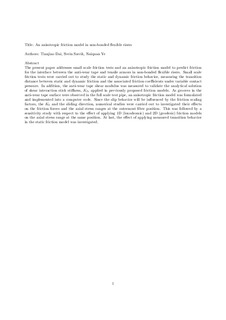| dc.contributor.author | Dai, Tianjiao | |
| dc.contributor.author | Sævik, Svein | |
| dc.contributor.author | Ye, Naiquan | |
| dc.date.accessioned | 2018-12-12T17:30:27Z | |
| dc.date.available | 2018-12-12T17:30:27Z | |
| dc.date.created | 2018-03-26T12:28:50Z | |
| dc.date.issued | 2018 | |
| dc.identifier.citation | Marine Structures. 2018, 59 423-443. | nb_NO |
| dc.identifier.issn | 0951-8339 | |
| dc.identifier.uri | http://hdl.handle.net/11250/2577497 | |
| dc.description.abstract | The present paper addresses small scale friction tests and an anisotropic friction model to predict friction for the interface between the anti-wear tape and tensile armors in non-bonded flexible risers. Small scale friction tests were carried out to study the static and dynamic friction behavior, measuring the transition distance between static and dynamic friction and the associated friction coefficients under variable contact pressure. In addition, the anti-wear tape shear modulus was measured to validate the analytical solution of shear interaction stick stiffness, K0 , applied in previously proposed friction models. As grooves in the anti-wear tape surface were observed in the full scale test pipe, an anisotropic friction model was formulated and implemented into a computer code. Since the slip behavior will be influenced by the friction scaling factors, the K0 and the sliding direction, numerical studies were carried out to investigated their effects on the friction forces and the axial stress ranges at the outermost fiber position. This was followed by a sensitivity study with respect to the effect of applying 1D (loxodromic) and 2D (geodesic) friction models on the axial stress range at the same position. At last, the effect of applying measured transition behavior in the static friction model was investigated. | nb_NO |
| dc.language.iso | eng | nb_NO |
| dc.publisher | Elsevier | nb_NO |
| dc.rights | Attribution-NonCommercial-NoDerivatives 4.0 Internasjonal | * |
| dc.rights.uri | http://creativecommons.org/licenses/by-nc-nd/4.0/deed.no | * |
| dc.title | An anisotropic friction model in non-bonded flexible risers | nb_NO |
| dc.type | Journal article | nb_NO |
| dc.type | Peer reviewed | nb_NO |
| dc.description.version | acceptedVersion | nb_NO |
| dc.subject.nsi | VDP::Offshoreteknologi: 581 | nb_NO |
| dc.subject.nsi | VDP::Offshore technology: 581 | nb_NO |
| dc.source.pagenumber | 423-443 | nb_NO |
| dc.source.volume | 59 | nb_NO |
| dc.source.journal | Marine Structures | nb_NO |
| dc.identifier.doi | 10.1016/j.marstruc.2018.02.012 | |
| dc.identifier.cristin | 1575714 | |
| dc.relation.project | Norges forskningsråd: 237929 | nb_NO |
| dc.description.localcode | © 2018. This is the authors’ accepted and refereed manuscript to the article. Locked until 6.3.2020 due to copyright restrictions. This manuscript version is made available under the CC-BY-NC-ND 4.0 license http://creativecommons.org/licenses/by-nc-nd/4.0/ | nb_NO |
| cristin.unitcode | 194,64,20,0 | |
| cristin.unitname | Institutt for marin teknikk | |
| cristin.ispublished | true | |
| cristin.fulltext | preprint | |
| cristin.fulltext | postprint | |
| cristin.qualitycode | 2 | |

